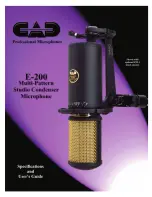
59
a) Action: Measure the voltage on each of the temperature channels.
7.4 Temperature Problem with one Function:
Temperature is measured on the aircraft using a temperature probe with type K thermocouple (TC) wire.
When the TC junction in the tip of the probe is heated, a small signal (approx. 23 micro volts per ‘F) is
produced and monitored by the EDC on two extension wires. These extension wires must be made of type
K TC material.
When measuring temperature with TC material an ambient reference temperature must be provided. This
is done with a reference diode located on pins 10 and 28 of the EDC Middle Connector. The ambient
temperature is added to the temperature measured at the TC junction.
Symptom:
Symptom:
Symptom:
Symptom:
Symptom: Inaccurate, jumpy or zero reading.
1. Problem: One of the two wires from the Temperature Probe to the EDC is open or shorted to
ground.
a) Action: Remove the extension cable from the probe. Ohm both wires to ground. Each
wire should measure 12.1K ohms to ground.
2. Problem: The temperature probe has a problem.
a) Action: Ohm between the two leads of the temperature probe. You should get a short
(<10 ohms)
Ohm one lead of the probe to ground. You should get an open (> 100K ohms).
7.5 RPM Problem:
For an engine with magnetos, a pulse is produced on the P-lead for each power stroke of the engine (three
pulses per revolution for a six cylinder engine). The pulses can be in the hundreds of volts. An Isolator is
connected between the P-lead and the EDC RPM inputs. The EDC monitors both magnetos.
The RPM reading for each RPM channel can be viewed in the "Function Configuration" screen found in
the "System Config Screens Menu." This screen can be very helpful when troubleshooting.
Symptom:
Symptom:
Symptom:
Symptom:
Symptom: Inaccurate, jumpy or zero reading.
1. Problem: An Isolator was NOT used between the EDC RPM channel and the P-lead at the
back of the Mag Switch. The signal on the P-lead is hundreds of volts and if an











































